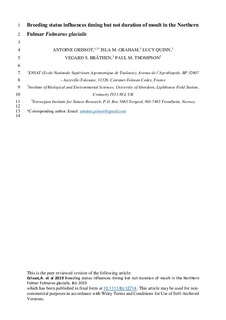Breeding status influences timing but not duration of moult in the Northern Fulmar Fulmarus glacialis
Journal article
Accepted version

Åpne
Permanent lenke
http://hdl.handle.net/11250/2590914Utgivelsesdato
2019Metadata
Vis full innførselSamlinger
- Scientific publications [1392]
Originalversjon
10.1111/ibi.12714Sammendrag
Seabirds are key marine top predator species that are often used as indicators of the environmental quality of the oceans. Their breeding phenology has been studied extensively, but their pelagic habits mean less is known about the phenology of other events during the non-breeding period. Here, we used miniaturized saltwater immersion lightbased geolocators (GLS) to investigate moult phenology in individuals with known breeding histories in a population of Northern Fulmar Fulmarus glacialis in Orkney, Scotland. As seabirds spend more time on the water during moult, moulting periods can be identified from patterns of variation in the amount of time that birds are in contact with saltwater. Estimates of daily variation in this behaviour during the non-breeding period were based upon wet/dry sensors and then modelled to characterize the timing of the moult. Light-based geolocation provided information on the areas used by each individual during its moult period. Inter-individual variability in moult timing was investigated in relation to sex and breeding success in the previous summer. We found a sex difference in the location of the moult, but not in its timing. However, the timing of moult did differ between individuals that had succeeded or failed in their previous breeding attempt, with successful breeders moulting the latest. In contrast, the duration of moult did not depend on prior reproductive success, but there was evidence of inter-annual variation in moult duration. GLS studies have provided a step change in our understanding of the at-sea distribution of pelagic seabirds. Our work highlights how activity data from these devices can add value to such studies by identifying key phases of the annual cycle, and locations at these times, when seabirds may be at particular risk. Furthermore, our findings indicate that individual and inter-annual variation in breeding success may influence phenological patterns in other phases of the Northern Fulmar annual cycle.